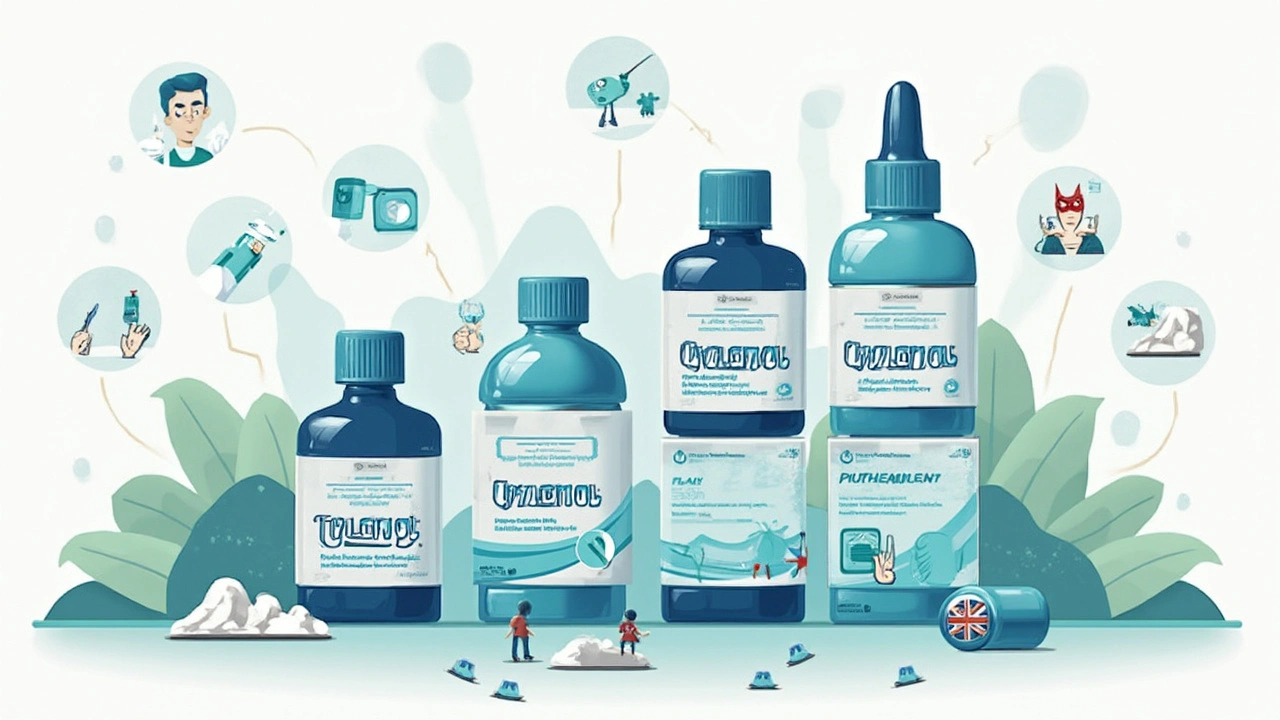Pop open just about any medicine cabinet and odds are you’ll spot a familiar white bottle—a bottle of Tylenol. People swear by it for those pounding headaches, sore back muscles, and pesky fevers. But how much do you really know about this over-the-counter giant? Whether you’re a college student prepping for finals, a parent caring for a feverish toddler, or someone who just pushed themselves a little too hard at the gym, you probably have questions about Tylenol. It’s a household name, but its story is deeper than it looks. Let’s pull back the curtain.
What Exactly Is Tylenol? Breaking Down the Science
Tylenol is the brand name for acetaminophen—that’s the real star of the show. It popped up in US pharmacies back in the 1950s and quickly became the go-to choice for folks looking to stave off pain or knock out a fever without a prescription. Other brands sell acetaminophen (or paracetamol, as it’s called in the UK) too, but Tylenol is the household term people stick with, like calling facial tissues "Kleenex."
Here’s what’s wild: scientists still don’t fully understand how acetaminophen works. The leading theory? It tweaks the brain’s pain- and heat-regulating centers, which dials down those feelings of pain and chills. Unlike NSAIDs like ibuprofen or aspirin, acetaminophen doesn’t put the brakes on inflammation. That’s why it won’t do much for swollen joints or sprained ankles, but it knocks out minor aches, headaches, and fevers with ease.
What really sets Tylenol apart? It’s less likely to cause stomach bleeding or irritation compared to NSAIDs and is safe for most adults and kids, even those who can’t take aspirin. Tylenol has no blood-thinning effects, so people on anticoagulants usually reach for it instead. Weirdly enough, nobody would know just how popular acetaminophen would become back in 1977 when it was added to the WHO’s list of essential medicines. Today, Americans swallow down 27 billion doses every year. You read that right—27 billion.
But here’s a quirky twist: acetaminophen is also hidden in more than 600 other medicines. We’re talking cough syrups, nighttime cold and flu relief, prescription painkillers—sometimes you wouldn’t even guess Tylenol is in there. That’s where unintentional overdoses come into play, but we’ll circle back to that.
Getting the Dosage Right: What Safe Use Really Looks Like
Everybody wants their pain gone yesterday, but too much Tylenol is a surefire way to get yourself into trouble. The max recommended dose for healthy adults is 4,000 mg in a 24-hour period. That means about eight regular strength (325 mg each) or six extra strength (500 mg each) tablets per day. But here’s the thing: plenty of specialists now urge folks to stay under 3,000 mg daily just to be extra safe. Why? Because the liver does the heavy lifting when breaking down acetaminophen, and overloading it can seriously harm you—even send you to the ER with liver failure. In fact, Tylenol overdose is the number one cause of acute liver failure in the US.
Kids have totally different needs. For children, Tylenol comes in drops or syrups—no pills. Dosing depends on weight, not age, and it’s crucial to check the label and use the syringe or cup that came in the box. Never use a random teaspoon from your kitchen drawer. A quick rule of thumb: for most kids, it’s about 10-15 mg per kilogram of body weight every 4-6 hours, max four times a day.
Mix-ups can be sneaky. A parent grabs a cold medicine that lists “acetaminophen” way down on the ingredients. Hours later, a fever flares, and they reach for Tylenol too. Before you know it, the dose doubles. Another easy way to misstep? Using the wrong concentration (infant drops vs. children’s syrup). Always double-check the label and ingredients before reaching for another med. If you’re unsure or the patient already has liver issues, call your doctor or pharmacist first. Better yet, try a mobile app that tracks doses and sets timers—you don’t need to memorize anything that way.

What Happens If You Use Tylenol Wrong?
Here’s where people get tripped up. Tylenol feels so safe, so “ordinary,” that it’s easy to forget the risk. Take too much, and you can do irreversible harm to your liver. One big single overdose—say, chasing sleep with too many cold-and-flu tablets—can land you in the ICU quickly. Long-term, if you frequently take high doses, liver cells die off a little at a time. Symptoms of acute Tylenol overdose might be sneaky: nausea, vomiting, belly pain. It takes a day or more for liver damage to really show itself, and by then, a lot of damage can already be done.
How common is a bad Tylenol accident? Every year, more than 56,000 people end up in US emergency rooms with acetaminophen overdoses. Of those, 500 end up dying. Just three consecutive days above the recommended max dose can push your liver over the edge, especially if you throw heavy drinking into the mix. Alcohol and Tylenol do not play nice together—alcohol weakens your liver’s natural defense, so even a little extra acetaminophen can be much more dangerous. There’s even a grim medical term for the cliff your liver falls off—“acetaminophen-induced hepatotoxicity.”
Here's one of the most overlooked dangers: people living with chronic pain or migraines sometimes pop Tylenol daily out of habit. That daily use adds up. If someone already deals with hepatitis or cirrhosis, a “regular” Tylenol dose might become hazardous. And, for pregnant women, Tylenol is actually the go-to nonprescription painkiller (since NSAIDs like ibuprofen are ruled out after 20 weeks). But new research in 2024 caused a stir, suggesting a possible link between long-term use in pregnancy and a slightly higher risk of ADHD in children. The real-world risk is tiny, but it got enough attention for experts to recommend using the lowest effective dose for the shortest possible time. When in doubt, always check with your healthcare provider before long-term use.
Practical tips for Smarter, Safer Relief
Want to get the most out of Tylenol and stay out of harm’s way? Start with the basics. Always read the drug facts label—don’t rely on memory. Dosing cups and syringes might sound silly, but they’re a lifesaver for accuracy. Keep a written log or notes app running if you’re giving it to more than one child or in the middle of a stressful night; hospital nurses do this for a reason.
Remember, taking Tylenol on an empty stomach is just fine—food doesn’t impact how it works. If you want better sleep, don’t be fooled by “PM” combos—with Tylenol PM, you’re getting acetaminophen plus diphenhydramine, an antihistamine. These products are best as a short-term fix because antihistamines can leave you groggy in the morning. And don’t stack regular Tylenol with other prescription pain medicines unless your doctor confirms it’s safe—many opioids (like Vicodin or Percocet) contain acetaminophen as well. Double-dosing is surprisingly easy to do if you aren’t attentive.
Store all Tylenol well out of reach from curious little hands. Childproof caps are handy, but not foolproof—kids are resourceful. Pay attention to the expiration date. Tylenol doesn’t “go bad” in the way food does, but it can lose potency; if you’re grabbing a dusty bottle from a corner cabinet, maybe grab a new one instead, especially when treating young children or those at high risk.
Be savvy: never use Tylenol to “prevent” pain before alcohol—it won’t work and raises your risk. If you have chronic liver disease, take other medications like warfarin, or you’re pregnant, check in with your doc before Tylenol becomes your go-to. And if you ever mess up the dosing—don't wait. Call your local poison control center or get to an ER. The antidote (N-acetylcysteine) works best if you get it within 8 hours after an overdose.
Here’s a final pro tip. For stubborn headaches or aches, try pairing Tylenol with a cup of coffee. There's evidence from real clinical trials that caffeine can enhance acetaminophen’s effect. That's why you’ll notice caffeine as an added ingredient in some “extra strength” headache formulas. As with everything, moderation is key—don’t overdo it.

Richie Lasit
May 31, 2025 AT 15:36Been using Tylenol since college finals and I never thought twice about it-until my buddy ended up in the ER after mixing it with whiskey and cold meds. Holy hell, that was a wake-up call. Now I always check labels, use a notes app to track doses, and never go over 3k mg. It’s not rocket science, but it’s easy to forget when you’re in pain and just want it gone.
arthur ball
June 1, 2025 AT 03:40OMG I JUST REALIZED I’VE BEEN GIVING MY KID THE INFANT DROPS BY ACCIDENT BECAUSE I THOUGHT THE BOTTLE LOOKED THE SAME 😭 like, why do they make these so confusing?? I used a kitchen tsp once-don’t judge me, I was exhausted. Now I keep the syringe taped to the fridge. Also, caffeine + tylenol for migraines? YES. Life hack. Coffee saved my workday twice last week.
Harrison Dearing
June 3, 2025 AT 01:3227 BILLION doses?? 😏 Someone’s got a lot of headaches. Or a lot of people who think Tylenol is a vitamin. Look, I get it-it’s everywhere. But if you’re popping it daily for ‘stress headaches’ while drinking, you’re basically playing Russian roulette with your liver. And no, coffee won’t save you. You’re not a superhero. Stop.
Justice Ward
June 3, 2025 AT 09:52There’s something quietly beautiful about how something so simple-this little white pill-can hold so much weight in people’s lives. It’s the quiet hero of the medicine cabinet, the one you reach for when the world’s too loud, the fever won’t break, or the back’s screaming after a long shift. But damn, it’s also the quiet assassin if you forget to respect it. I’ve seen too many people treat it like candy. It’s not. It’s a tool. A powerful, delicate one. Treat it like you’d treat a chainsaw: know its limits, respect its edge, and never use it blindfolded.
bhuvanesh kankani
June 4, 2025 AT 07:25In India, acetaminophen is commonly known as paracetamol and is equally prevalent. However, awareness of its hepatic risks is often lacking in rural communities. Many assume that because it is over-the-counter, it is inherently safe. Public health education must emphasize dosage limits and hidden ingredients in combination products. The WHO listing is a good start, but local outreach is essential to prevent preventable liver injuries.
maria norman
June 4, 2025 AT 08:00So we’re supposed to believe that Tylenol is the ‘safe’ option because it doesn’t hurt your stomach… but it quietly murders your liver instead? How very American. Replace one risk with a slower, more insidious one. And now we’re told to use caffeine to boost it? Brilliant. Next up: adding sugar to painkillers so we can pretend we’re not just medicating our entire existence. 🙃
Iris Schaper
June 5, 2025 AT 09:56just read this whole thing and now i feel like a monster for taking tylenol every time my head hurts. i mean… i know it’s bad but i also just… need to function. also i didn’t know it was in like 600 other things. my cold medicine has it? no way. now i’m paranoid. maybe i should just cry in a dark room instead.